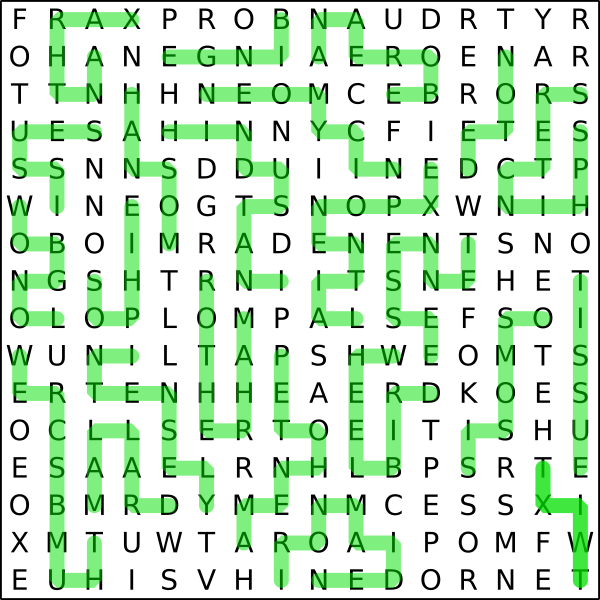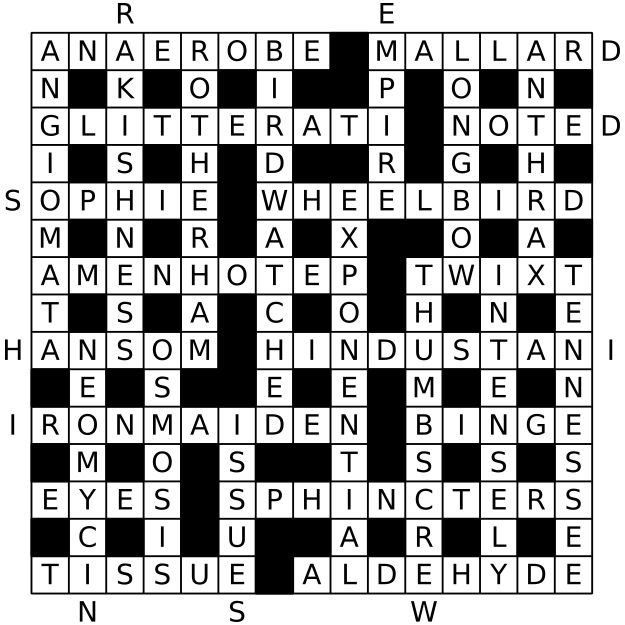| Home Register Puzzles Solve Teams Statistics Rules Solving Guide F.A.Q. Archive mezzacotta |
Solution: 4A. All Astir
We are presented with a set of 30 words and what looks like a standard find-a-word or word search puzzle grid. The most obvious thing to do is to look for the given words in the grid.
A brief scan reveals that none of the words are found in the conventional manner, running in straight lines. However, with some effort, several can be found by starting at a letter and then choosing horizontally or vertically adjacent letters at each step, creating a wriggling path. Finding as many words from the list as we can in this way, we can also constrain them so none of the found words overlap. In the end, we can find 23 of the 30 words, with no sign of the remaining 7. The result looks like this:

The usual thing to do in a word search puzzle is to look for a hidden message spelled out by the leftover letters. Reading them across lines and then down the grid gives the following:
FPROUDRTYRONEARTHCR FINDING WORDS NOT HELPFUL SO TAKE OTHER PROCESS XUWTPOMFEISVHORNE
There are a few words such as PROUD and EARTH lurking in the gibberish at the edges, but in the middle is what seems to be a clear message. Unfortunately it seems to be telling us that what we've done is not the right thing to do! What else is there? Looking at the words might reveal a few intriguing relationships, such as Iron Maiden and Thumbscrew both being torture devices, while Anthrax and Iron Maiden are both heavy metal bands. But trying to find any further line of attack on the puzzle this way is ultimately fruitless.
The twist to this puzzle which needs to be realised is that all of the Thursday puzzles in this competition are interrelated, and rely on information from other puzzles. The correct thing to do here is to ignore the grid and instead fit the supplied list of words into the empty crossword grid from puzzle 4C. Crossover Word. This revelation is difficult to make in isolation, but becomes feasible once the interrelationship of all the puzzles is realised (probably through the more obvious interaction between puzzles 4B and 4C - see the solution for 4B).
There is still a small problem, however. The words don't fit into the empty crossword grid! Not exactly anyway. In particular, there are too many 11-letter words. Nevertheless, if we plough ahead and try to fit them into the grid anyway (perhaps motivated by progress on the other Thursday puzzles, leaving the list of words and the empty grid as the only remaining unused pieces of information), we can succeed, with several words protruding from the grid by a single letter:

The letters dangling outside the grid can be read, anticlockwise (or widdershins), to spell the word WIDDERSHINS. "Widdershins" is an old word meaning anticlockwise, and is often cited as the correct direction in which to stir a magical brew. This provides a connection to the puzzle title, "All Astir", confirming that the answer is to this puzzle, as opposed to being the answer to 3C. Crossover Word.
The solution is WIDDERSHINS.
Puzzle design notes
The idea for a group of five inter-related puzzles originally arose in the aftermath of the 2013 CiSRA Puzzle Competition. Beginning with the 2010 competition, we'd developed a tradition that our group 4 puzzles would form what we privately dubbed "mess with heads" day. For four years we'd presented a set of group 4 puzzles that defied conventional puzzle expectations in some way.
- In 2010 we presented a set of four puzzles which all looked like the same puzzle.
- In 2011 we presented a series of "meta" puzzles. Not "metapuzzles" that use the answers of other puzzles, but puzzles that explored the semantic space of puzzles in unexpected ways. One puzzle was a commentary about puzzle clichés, one appeared to be a puzzle team statistics page from the puzzle competition itself, one appeared to be a leaked email between puzzle designers giving away secrets about a puzzle, and one appeared to be an accidentally uploaded puzzle solution rather than the puzzle.
- In 2012, each of the group 4 puzzles appeared to be a puzzle similar to a previously released puzzle from an earlier day of the same competition - except missing some of the vital clues.
- In 2013, there were five group 4 puzzles, presented as cut up jigsaw pieces, mixed together across the five puzzle PDF files. But when you cut them out and reassembled them, there only appeared to be four puzzles! The first part of the fifth puzzle was working out where the fifth puzzle actually was.
In initial planning for a 2014 competition, I had the idea of making a set of puzzles that all look relatively conventional at first glance, but which actually all require information found in other puzzles to solve. There would be a word search, but the words wouldn't actually be in the grid of letters - you'd need to do something else with them. There would be a crossword puzzle, but the clued words wouldn't fit into the grid - you'd need to figure out what other puzzle needed to use the words. And so on.
But as events turned out, CiSRA decided not to hold a competition in 2014. So the idea got put on ice. Then in 2015, CiSRA decided not to sponsor the competition any more. After taking stock, we decided to begin our own private competition, aiming for 2016 as the first year. And so I turned back to the interlinked set of five puzzles idea. By this time most of my fellow puzzle creators had forgotten about my idea (which I'd shared back in 2013), so I kept it secret and worked on the set by myself.
The development of the puzzles followed a long and tortuous path of mutual constraints, which is best followed by referring to the puzzle design notes for some of the other puzzles first. If you wish to read the creative process in a roughly chronological order, I suggest reading the following design notes first, and then returning here:
After those three puzzles and their interactions had been designed, I had my list of 30 words for this puzzle, and a partly filled grid of letters (as seen in the designer notes for 4D. Signs of Change). Most of the letters in the grid still remained to be filled. I decided that to enhance the impression of a conventional puzzle, it would be good to use these free letters to actually place some of the 30 words into the grid. I quickly realised that the standard method of having words run in straight lines would result in almost none of them fitting. So I tried the horizontal and vertical snaking method, with no intersections, as seen in the final puzzle.
On my first attempt I managed to squeeze 28 of the 30 words into the grid, using as many of the fixed letters as I could. But try as I might, the last two wouldn't fit. It didn't matter much, as actually finding the words in the grid was a dead end anyway! So I finished off designing all the puzzles, and gave them to the test solvers.
Predictably, they started finding words in the grid. When they got to 28, they still hadn't realised the connections between the puzzles, and thought something was amiss. Soon they discovered the "coincidence" between the crossword clues in 4C. Crossover Word and the painting titles in 4B. Art Elsewhere, and the light bulb went off. However, despite knowing the puzzles were interconnected, they persisted for some time in struggling with the missing two words in the word finder grid.
Eventually they figured it all out, solving all five puzzles. But they gave the feedback that finding 28 of the 30 words in this puzzle was too compelling, and so not easy to give up to explore in other directions. They suggested it would be less of a red herring rabbit hole if significantly fewer words could be found in the grid, and if they left over letters spelled out some sort of message to tell solvers that they were doing the wrong thing. (In this version, the leftover letters were almost all constrained and it was impossible to weave a message into them, so there was none.)
So I went back to the drawing board. The first step was to construct the message. Unfortunately, so many of the letters were fixed by the interactions of puzzles 4C, 4D, and 4E, that this was very difficult. Every one of those fixed letters had to be either used in the message itself, or had to be covered by one of the snaking words in the list of 30. In the end, this was impossible, and I had to settle for burying a coherent message in the middle of a bunch of random gibberish. Even this was ridiculously difficult, and I juggled with various possibilities for several days, finally ending up with the message: FINDING WORDS NOT HELPFUL SO TAKE OTHER PROCESS.
The word choice is a little odd because of the constraints on what letters I had to use. In particular, I had to use TAKE OTHER PROCESS instead of something more natural like TRY SOMETHING ELSE. There was a small concern that the message couldn't be started at the top of the grid and so had to be prefaced by gibberish. If teams began extracting a message and saw obvious gibberish, they might give up before getting to the beginning of the message. So with some of the free letters I constructed words around the fixed letters, including PROUD, TYRONE, and EARTH. If you noticed these, the only reason they were there was to encourage solvers to keep going and extract the full message, rather than give up after only 20 or so letters.
